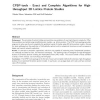63 search results - page 7 / 13 » A coprocessor architecture for fast protein structure predic... |
ISMB
2000
13 years 9 months ago
2000
Knowing the number of residue contacts in a protein is crucial for deriving constraints useful in modeling protein folding, protein structure, and/or scoring remote homology searc...
BMCBI
2008
13 years 7 months ago
2008
Background: The principles of protein folding and evolution pose problems of very high inherent complexity. Often these problems are tackled using simplified protein models, e.g. ...
ICIP
2009
IEEE
13 years 5 months ago
2009
IEEE
This article introduces a fast algorithm for Connected Component Labeling of binary images called Light Speed Labeling. It is segment-based and a line-relative labeling that was e...
BMCBI
2010
13 years 7 months ago
2010
Background: Ab initio protein structure prediction methods generate numerous structural candidates, which are referred to as decoys. The decoy with the most number of neighbors of...
PAKDD
2009
ACM
14 years 5 days ago
2009
ACM
Abstract. Over the last decade several prediction methods have been developed for determining structural and functional properties of individual protein residues using sequence and...

